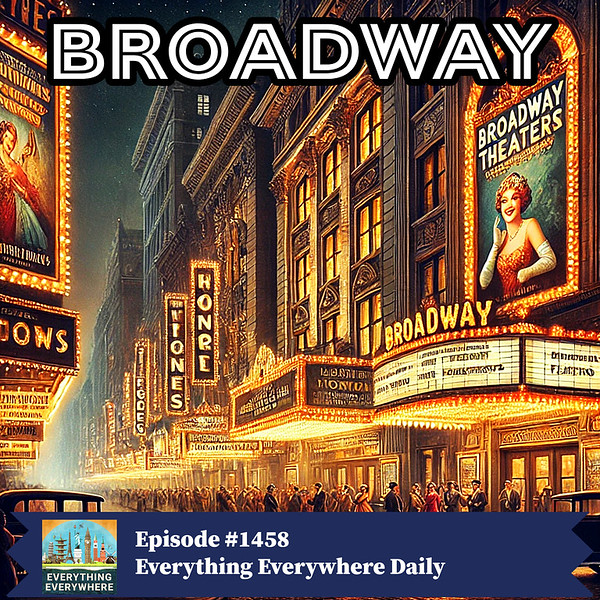Subscribe
Apple | Spotify | Amazon | iHeart Radio | Player.FM | TuneIn
Castbox | Podurama | Podcast Republic | RSS | Patreon
Podcast Transcript
One of the leading destinations for live stage performances is Broadway.
The term Broadway is not just a name that refers to theater in New York City. It also describes a theatrical performance style that has become synonymous with it.
But why did theater develop on that particular street in that particular city, what divides Broadway from off-Broaday, and how exactly does Broadway work as a business?
Learn more about Broadway, its history, and how it functions as a business on this episode of Everything Everywhere Daily.
Acting and live performances go way back in history. Theater and plays were performed in ancient Greece at least 2500 years ago, a tradition later taken to Rome.
Theater in the form of Chinese operas was performed at least 3000 years ago, and dramatic Sanskrit plays were performed in India about 3500 years ago.
There were different types of performances. Sometimes, they were ways of retelling historical stories. Some were musicals. Some were comedies and other times, they were biting social commentary.
The theater has existed in some form or another in most civilizations throughout recorded history.
So, it should come as no surprise that theater came along when people started migrating to North America.
When the Dutch founded the settlement of New Amsterdam, it was largely settled by devout Protestants who had no need for such frivolities as theater.
When the British later took over, they had a more relaxed attitude towards theater and entertainment. The primary leisure activity was drinking alcohol. The first theatrical performances in New York might have taken place at one of the first coffee houses in the city, The King’s Arms, which opened in 1696.
It was located just south of Trinity Church on Broadway, close to Wall Street.
In 1732, a troop of actors from London came to New York and performed in the unoccupied second floor of a building at the intersection of Maiden Lane and Pearl Street. Their first performance, which is believed to be the first professional theatrical performance in the city, took place on December 6, 1732. The play was called The Recruiting Officer.
This was not a theater per se, just an empty space.
The first professional theater in New York, built for theatrical purposes, is believed to have been the Theatre on Nassau Street, built in 1750. It was a two-story wooden building that sat 280 people. Their first performance was Richard III, and they performed the first musical, The Beggars Opera.
During the Revolutionary War, the British, who occupied New York, suspended all theatrical performances. After the war, when the British left, New York briefly became the capital of the new United States. There are records of George Washington attending the theater while he was president.
The first theater that could be called a proper Broadway theater was the Park Theater, built in 1798. It seated 2000 people with different sections for people of different social classes. Princes ranged from 25 cents for the cheap seats to one dollar for the elite boxes.
It was located across from what is today City Hall Park, just off Broadway.
Here, I briefly describe what Broadway, the street is. Broadway is the oldest north/south thoroughfare in the city. It was built on what was formerly a trail used by Native Americans on the island.
It extends for 13 miles, starting in lower Manhattan and crossing into the Bronx. It actually keeps going outside of New York City, running alongside the Hudson River, eventually becoming New York State Highway 9.
The name comes from the Dutch word “brede weg,” which means broad street. Broadway is technically classified as a street in New York, not an avenue, but it is not labeled as such. It is not known as Broadway Street, just….Broadway.
For the purposes of this episode, it is one of, if not the most important street in New York, and where it intersects with Seventh Avenue and 42nd Street, it forms Times Square, which is the heart of New York City.
As New York rapidly grew in the 19th century, more theaters were built. The next major theater was The Bowery Theatre, built in 1826, which sat 3,500.
The entertainment center of the city migrated from downtown to uptown around 1850, moving from Union Square to Madison Square.
As the city grew, Broadway the street became more important and it was a natural magnet for buildings such as theaters that attracted large audiences.
The association of Broadway with theater, and not just the name of a street, began after the Civil War.
In 1866, what is considered to be the first modern musical was produced, The Black Crook. It first premiered at the 3,200-seat Niblo’s Garden Theater on Broadway.
Around this time, the first performances began to go on tour outside of New York. When they performed in other cities, they often used the phrase “direct from Broadway” in their promotions.
Throughout the 19th century, theaters kept moving up Broadway until around the year 1900, when the center of activity became Times Square.
Theater became big business in New York. There were dozens of theatres located on or near Broadway.
Broadway theaters began installing lights on their marquees to get the public’s attention. Because colored bulbs burned out too quickly, they only used white lights. By 1904, the term the “Great White Way” had appeared in the New York Times to describe the spectacle.
Shows began to have extended runs, which would last for years. Previously, almost all performances had limited runs. The first Broadway show to have 1,000 performances was Lightnin’, which was first performed in 1918.
The 1920s ushered in the first Golden Age of Broadway.
This period was largely driven by competition from motion pictures. Previously, live performances were the only entertainment game in town. Now, theaters had to compete against cinemas that were showing prerecorded content that only had to be performed once.
With pressure from movies, stage productions became more elaborate and expensive. Cheaper vaudeville productions died out and were replaced by larger spectacles, popular songs, and celebrities.
The biggest name in these stage spectacles was probably Florenz Ziegfeld. Ziegfeld produced a series of reviews from 1907 to 1931 known as Ziegfeld Follies.
The Ziegfeld Follies didn’t have a plot or a storyline. Many of the biggest celebrities of the day would appear on stage, such as WC Fields, Bob Hope, Eddie Cantor, Josephine Baker, and Fanny Brice.
The show was also famous for its numerous beautiful chorus girls. They would often wear elaborate costumes combined with dance routines.
Productions like the The Ziegfeld Follies were not the only type of stage performance.
Other shows like Showboat and Hamlet were more standard musicals or plays.
1930 saw the establishment of the Broadway League. The Broadway League began as a group of theater owners trying to combat ticket scalping, but it soon grew into a trade association for the Broadway theater industry.
By 1938, it became the industry group that negotiated with unions that worked on Broadway productions, including Actors Equity, which was founded in 1913.
The Great Depression and Second World War did serious harm to Broadway, but it managed to survive. The post-war era saw another golden age of Broadway.
Many of the classic musicals you are probably familiar with came out in the 1940s and 1950s. This period is widely considered to have begun with the release of Oklahoma! in 1943. There were several musicals from Rogers and Hammerstein, which were all hits during this period, including Oklahoma!, Carousel, South Pacific, The King and I, and The Sound of Music.
This period also saw the production of plays written by the likes of Tennessee Williams and Arthur Miller.
The 1960s saw the start of a decline in Broadway productions, which had to do with the rise of television and the decline of the theater district around Times Square. By the 1970s, Times Square was considered to be a dirty and unsafe neighborhood that you wouldn’t want to bring families.
In the early 1980s, there was concern that many Broadway theaters would be sold to real estate developers and torn down. However, a revitalization program in the Theater District and Times Square cleaned up the neighborhood, which helped usher in a resurgence in Broadway with productions like Cats, Miss Saigon, and Phantom of the Opera.
In the 21st century, one of the big trends has been to create productions based on movies or recording artists. These shows tend to be popular with tourists to New York who are already familiar with the work.
Today, Broadway productions have become a major industry.
For starters, a Broadway show has a very particular meaning. I’ve been using the term rather generically, but there is a very specific definition of what Broadway means.
A Broadway show is any show that performs at one of 41 theaters in New York City, all of which are located in Midtown Manhattan. All of the theaters can seat at least 500 people, but none of them seat more than 2000.
If you are not at one of the 41 listed theaters, then you are an off-Broadway production.
This is very similar to London’s West End, which is the London Theater District, which has 39 specific theaters.
In the 2022-2023 theater season, Broadway performances had total revenues of $1,577,586,897. That represented a total attendance of 12,283,399, which means that the average ticket price was $128.43.
Generally speaking, a Broadway show will cost less to produce than a Hollywood movie. The average production cost of a Broadway musical can run about $10 to 20 million, and a play can run between $3 to 5 million.
However, there is a lot of variance in thosenumbers. A one-person play could have an extremely simple set, few costume changes, and a small crew.
On the other extreme, shows with extremely elaborate sets and large casts can cost much more. The most expensive Broadway show in history is believed to have been Spider-Man: Turn Off the Dark which cost $75 million dollars.
Despite setting the single-week record for ticket sales, it ultimately closed after a run of about 18 months, having taken massive losses.
Some successful Broadway productions will create a touring production in addition to the production in New York. For example, at the time I am recording this, a production of Hamilton is being run on Broadway, in London’s West End, and there two different touring productions. However, there have been as many as six different touring versions, and there were runs in Hamburg, Chicago, and Australia.
The Broadway League, which I previously mentioned, is also the organization behind the Tony Awards.
The Tony Awards are officially known as the Antoinette Perry Award for Excellence in Broadway Theatre. Antoinette Perry was an actress who lived from 1888 to 1946 and was the co-founder of the American Theater Wing. Her nickname was Tony, and her nickname became attached to the awards.
The awards were first given out in 1947 and have been given out subsequently every year.
For a show to be eligible for the major awards, it has to have been a new production that opened during that year’s theater season and has appeared at one of the 41 Broadway theaters. The cutoff date is usually sometime in April.
Even though some stage productions might go on for years, they are only eligible for a Tony Award in the year that they open.
However, if a new show has been revived, then they are eligible for the best revival category for a play or musical.
Death of a Salesman by Arthur Miller won Best Play in 1949 and then subsequently won Best Revival in 1984, 1999, and 2012.
The show with the most Tony Award nominations was Hamilton, which received 16 nominations in 13 categories in 2016 and won 11 awards.
The most awards ever won by a production was the Producers, which won 12 awards in 2001.
The actor with the most competitive Tony award wins is Audra McDonald, who has won six Tony Awards.
While in the general sense, Broadway shows can be appreciated almost anywhere, technically, if you want to see a Broadway show, you have to go to New York City.
The Executive Producer of Everything Everywhere Daily is Charles Daniel.
The associate producers are Ben Long and Cameron Kieffer.
Today’s review comes from listener Not Tom Selleck on Apple Podcasts in the United States. They write:
The best!
I recently discovered this podcast, and I am hooked, digging into the back catalog and finding myself absorbed in topics that I would never have guessed. The narrator’s style is smooth and easy, with no fluff, but is very engaging with his subject matter. I think it might be time to find that Patreon to get some merch!
Thanks, Not Tom Selleck! I know I keep talking about selling direct merchandise, but I think I’m finally close to doing it.
Also, Not Tom Selleck, I did not enjoy you in Magnum PI, and I also didn’t like your performance as General Eisenhower in Ike: Countdown to D-Day. That is because you are Not Tom Selleck.
Remember that if you leave a review or send me a boostagram, you too can have it read on the show.



